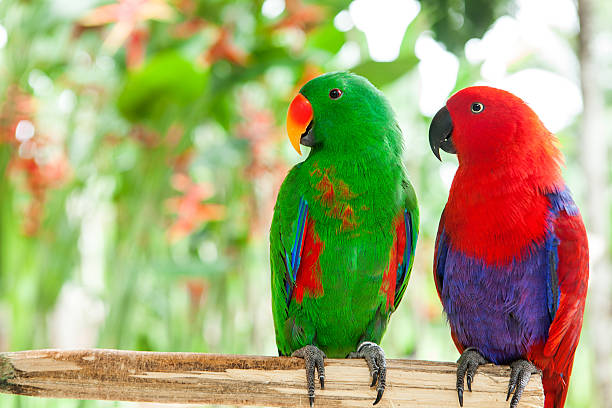You asked for it! You got it! Here is a list of birds that start with the letter E. Each entry includes a photo, description, and common name. I’ve also provided images for quick identification purposes. Now hopefully you can identify the birds on your feeder easier or you can impress people at the bird club with your knowledge. Regardless, I hope you find this list useful!
Emu (Dromaius novaehollandiae)
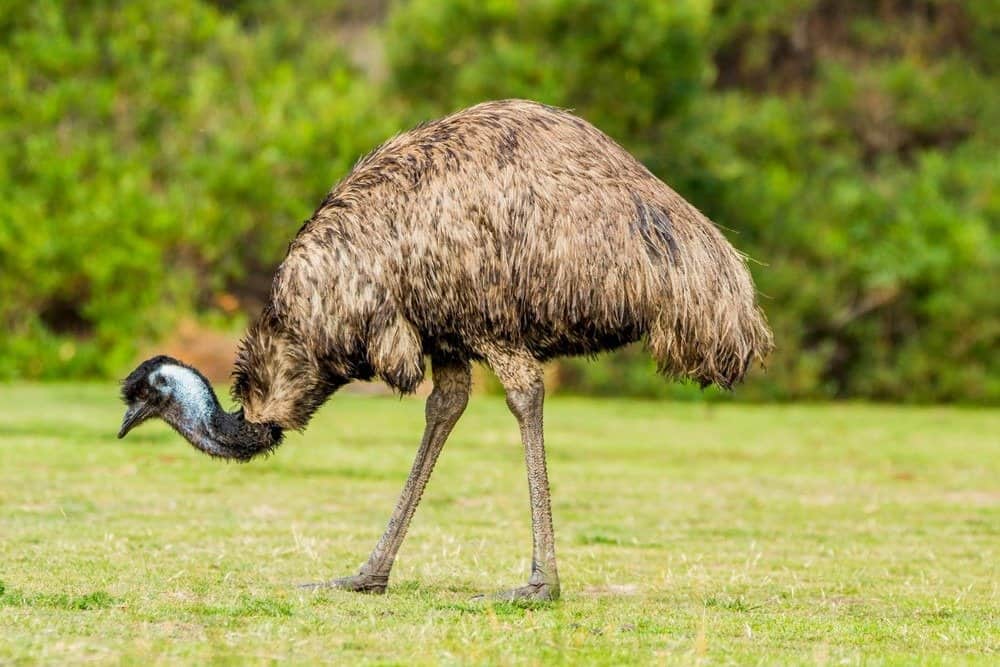
Declared as the second-largest bird species in the entire world, the Emus are a large, flightless bird species. They’re endemic to Australia; while Australia was once home to other ratites, Emus are the only extant ratite species there today.
Emus are similar to the Ostriches; only they’re smaller, shorter, and lighter in body mass than the latter. They have a small head, a long neck, and a wide body supported by two long legs.
While these birds are flightless, they do have an incredible speed on the ground and can even run at a speed of over 31 miles per hour.
Although both sexes of the adults have identical plumage, they do have other differences. The females are known to have a wider rump than their male counterparts and are also larger than them.
Emus have an average lifespan of 10-20 years in the wild and can survive up to 35 years in captivity.
Emperor Goose (Anser canagicus)

The Emperor Geese are a migratory goose species that breed in the sub-arctic and arctic climates. In the United States, you can find these waterfowls along the coasts and mudflats of Alaska during winters.
These birds’ heads and upper necks are stark white, while their under-neck and lower body are colored in bluish-black contrastingly. While the shade at their throat is pitch dark towards the lower part of their body, the plumage is heavily streaked with white, lending them a scaled appearance.
While both sexes of the adults have identical plumage, the females are slightly shorter than their male counterparts, which can distinguish between the two.
Due to climatic changes and increasing pollution, the population of Emperor Geese is steadily declining, which is why the IUCN has placed them in the Near Threatened List.
European Robin (Erithacus rubecula)

The European Robins are a Eurasian passerine species belonging to the Old World Flycatcher family (subfamily: chats). These birds are so popular for their reddish-rufous breast that they’re nicknamed “Robin Redbreast” in Great Britain.
While these robins are often compared to the American Robins (which is actually a thrush species), the two are not closely related.
European Robins have a small, stocky body with a pale grey head and darker wings and tail. On their chest is the characteristic reddish touch that spreads up to their bill. Underneath, their belly and rump are colored similar to their back, only paler. The adults are monochromatic.
Emperor Penguin (Aptenodytes forsteri)

Emperor Penguins are the largest of all surviving penguin species in the world. These flightless birds are native to Antarctica. Interestingly enough, they’re also the only penguins to breed in the Antarctic winters.
The body mass of an adult Emperor Penguin ideally ranges between 22-45 kilograms, making them the heaviest penguin species and the fifth heaviest of all birds found on Earth.
During winters, you can see a steep decline in the weight of both sexes, as they lose a lot of mass in breeding and incubation.
Like all the other penguin species, these birds possess a blackhead, throat, back, tail, and outer flippers, coupled with a contrastingly white belly and under-flippers. On their chest, they have touches of yellow. The adult Emperor Penguins are sexually monomorphic.
Eastern Kingbird (Tyrannus tyrannus)
Eastern Kingbirds are an American tyrant flycatcher species that breed in North America and migrate to Central and South America during winters.
These birds are primarily insectivores, catching insects mid-flight. However, you can also find them attracted to fruits and berries, particularly during migration.
Within the tyrant flycatcher family, the Eastern Kingbirds are one of the larger species. They have a dark, blackish-grey head, wings, and tail, with bold white wing and tail tips. Their irises, bill, and legs are all dark in color as well.
Eurasian Sparrowhawk (Accipiter nisus)
Also referred to as “Northern Sparrowhawk” or simply “Sparrowhawk,” the Eurasian Sparrowhawks are a raptor species with a widespread distribution throughout the Old World.
While these birds are generally a resident species, their northernmost populations are seen migrating to the south during winters.
Both sexes of these birds have different dietary preferences; the females primarily target starlings and thrush, while their male counterparts prefer smaller birds, such as sparrows, tits, and finches.
The adult Eurasian Sparrowhawks display significant sexual dimorphism. The females are the larger ones and weigh twice as much as their male counterparts. They have an overall brownish-grey plumage, while males are mainly bluish-grey in color.
Egyptian Goose (Alopochen aegyptiaca)
The Egyptian Geese have been named after their frequent appearance in ancient Egyptian culture and artwork. These waterfowls are endemic to Africa, where they are found in abundance south of the Sahara and along the Nile Valley.
The feral populations of Emperor Geese can also be found in the United States, New Zealand, and western parts of Europe.
These birds have a buff-colored body with touches of grey and brown here and there. The adults are sexually monochromatic but display dimorphism in size, with the males being larger.
Eurasian Pygmy-owl (Glaudicium passerinum)
As their name suggests, the Eurasian Pygmy-owls are the smallest owl species found in Europe. These owls are generally a resident species, although some populations might be seen migrating south during harsh winters.
Eurasian Pygmy-owls have a greyish-brown body with a reddish tinge on their back, with a darker tail. They have a short, hook-like beak that is yellow, coupled with yellow eyes.
Both sexes of the adults have identical plumage; only the females are larger in size. Both sexes have disproportionately large feet.
Emerald Starling (Lamprotornis iris)

Also referred to as “Iris Glossy Starling,” the Emerald Starlings are a tiny starling species in western Africa. These birds primarily inhabit savannahs and lowlands.
They’re glossy starlings with a metallic green crown, back, wings, and tail, with a metallic purple coat on their ear coverts and underparts. The adults are sexually monomorphic.
European Starling’s diet consists of small berries, figs, fruits, seeds, and small insects. Although their population is not properly estimated at the moment, it is noticed that the increasing mining activities have negatively influenced it.
Evening Grosbeak (Hesperiphona vespertina)

The Evening Grosbeaks are members of the finch family that are common across North America.
Although these birds were once found in abundance within their range, recently, their population has seen a severe decline, which is why they’re included in the Vulnerable Species List by the IUCN. Within the United States, you can spot them in the western mountain ranges.
Evening Grosbeaks are closely related to the Hooded Grosbeaks and share a similar plumage coloration. In appearance, they share more similarities to the Eurasian Hawfinches.
The adult Evening Grosbeaks are sexually dimorphic. The males have a brown face extending up to their upper neck. The rest of their body is yellow, along with a yellow forehead.
On the other hand, the females are mainly olive-brown, with greyer underparts.
Eurasian Teal (Anas crecca)
Eurasian Teals are a widely distributed, migratory dabbling duck species known to breed in the temperate areas of Euroserbia. During the winters, you can find these ducks traveling to the southern parts of their range.
Eurasian Teals are highly sociable waterfowls that always migrate in large flocks. However, in their breeding month, these birds prefer privacy.
Within the dabbling duck family, they’re among the smallest living members. The adult sexes appear similar in the non-breeding seasons, while the males change their plumage during the breeding months.
Elf Owl (Micrathene whitneyi)

Just as their name suggests, the Elf Owls are the smallest members of the true owl family.
They’re a migratory owl species that migrate to the southwestern regions of the United States in the early spring months. During this time, you can spot them in New Mexico, Arizona, and California.
Elf Owls are not only small but also very lightweight, with their body mass not crossing even 50 grams. Their flight feathers are longer than their bodies and have long bow-like legs.
The body of Elf Owls is a camouflaged mottled brown, with white wing and tail tips. They also have characteristic yellow eye-rings.
Electus Parrot (Electus roratus)
The Electus Parrots are stocky, short-tailed parrots found throughout northeastern Australia, New Guinea, Solomon Islands, and the Maluku Islands.
These parrots are well-known for the unusually prominent sexual dimorphism seen in the adults’ plumage. The males have a bright green body with an orange bill and eye rings. They also have red flanks and blue primary flight wings.
In contrast, their female counterparts are bright red with purple underpants. Their wings are darker in shade, with a yellowish-orange tail.
The feathers of Electus Parrots are often used as items of indoor decoration for the tribesmen of New Guinea.
Eastern Osprey (Pandion cristatus)
The Eastern Ospreys are a fish-eating raptor species inhabiting the coasts of New Guinea, the Philippines, the Indonesian islands, and Australia. Due to their eating habits, these birds of prey are often seen around large water bodies.
Eastern Ospreys have a white head and underparts, with brown streaks running along with their eyes. Their back, wings, and tail are dark brown in contrast. On their chest, you can notice brown barring.
Displaying sexual dimorphism, the female Eastern Ospreys are larger in size and display darker chest barring than their male counterparts.
Eurasian Bittern (Botaurus stellaris)
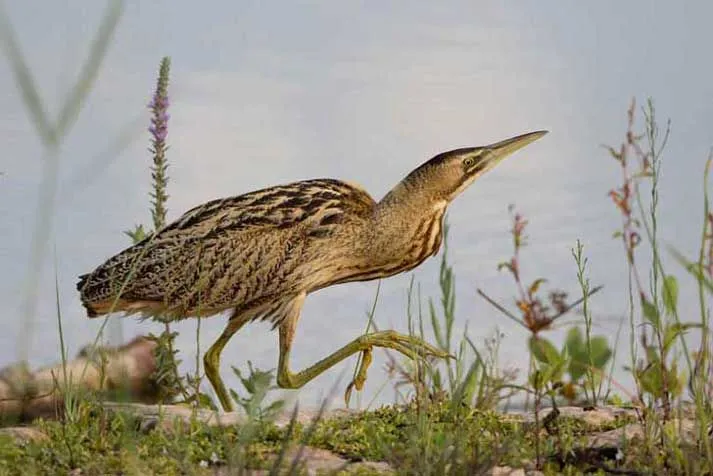
Also known as “Great Bittern,” the Eurasian Bitterns are among the larger members of the heron family. They have two subspecies: the northern one residing in Europe and the southern race in southern Africa.
Being the largest among all bittern species, these wading birds have a buff-colored plumage with dark brown streaks scattered all over. Both sexes of the adults have similar plumage; only the males are larger in size.
Eastern Phoebe (Sayornis phoebe)
Eastern Phoebes are a large-headed, migratory phoebe species that are found in the eastern regions of North America in the spring and summer months.
During the winters, these birds travel to the southernmost parts of the United States and Central America.
The upper half of their face is dark grey, along with their back, wings, and tail. In contrast, their underparts are white.
Eastern Screech Owl (Megascops asio)
Commonly found in densely wooded areas, the Eastern Screech Owls are a true owl species primarily inhabiting eastern North America.
These owls practice a strictly nocturnal schedule and are sexually monomorphic. They have a stocky body coupled with broad wings and a short tail. You can easily notice their prominent ear tufts. Eastern Screech Owls are the heaviest of all screech owls.
Eurasian Spoonbill (Platalea leucorodia)

Closely related to the Royal Spoonbills, the Eurasian Spoonbills are a migratory wading bird species that breed in North Africa, Spain, and the United Kingdom. During the winter months, they travel south to Africa.
Eurasian Spoonbills have an overall white body except for dark legs and the characteristic, spoon-like bill. Their bill is also dark but has a yellow tip.
Emerald Tanager (Tangara florida)
Found in Ecuador, Panama, Costa Rica, and Columbia, the Emerald Tanagers are medium-sized tanagers inhabiting the moist lowland and montane forests.
These birds are overall bright green in color with touches of yellow on their crown and rump. They have dark eyes, bills, and legs, with black markings on their cheeks and wings.
Egyptian Vulture (Neophron percnopterus)
The Egyptian Vultures are a vulnerable Old World Vulture species distributed across India, North Africa, and the Iberian Peninsula.
These birds are also referred to by other names, such as “Pharaoh’s Chicken” and “White Scavenger Vulture.” True to the latter name, they have an overall white plumage with black flight feathers. Their bill is colored in a bright shade of yellow.
Elegant Tern (Thalasseus elegans)
Breeding across the southern coasts of the United States, the Elegant Terns are a migratory seabird species that are significantly less aggressive than other terns. During the winter months, they migrate to Chile, Peru, and Ecuador.
These birds have a white face and underparts, a black cap, and grey wings and tails. Their bill is remarkably orange. Both sexes harbor a similar plumage.
Eastern Towhee (Pipilo erythrophthalmus)
/eastern-towhee-97e2668f33f04e3ea4368f919fdc27c7.jpg)
The Eastern Towhees are a large Old World Sparrow species that inhabit brushy landscapes in eastern North America.
These birds are sexually dimorphic in plumage, with the males having a black head, back, wings, and tail. They also have rufous flanks and a white belly. The black parts are brown in their female counterparts.
Eurasian Wigeon (Mareca penelope)
Also referred to as the “Widgeon,” the Eurasian Wigeons are members of the dabbling duck group found in the northernmost areas of Europe.
These waterfowls are sexually dimorphic, with the males having a grey back and flanks and a white patch on their upper wings. On the other hand, their female counterparts have a dull brown plumage.
Eared Dove (Zenaida auriculata)
Named after the prominent black lines running on the side of their faces, the Eared Doves are members of the New World Dove family.
These doves are resident species distributed across South America. However, you might find them migrating to other locations driven by their search for new food sources.
Eared Doves have a muted, olive-brown head and upperparts, with a warm orangish touch on their belly. Their female counterparts harbor a duller plumage.
Eastern Bluebird (Sialia sialis)
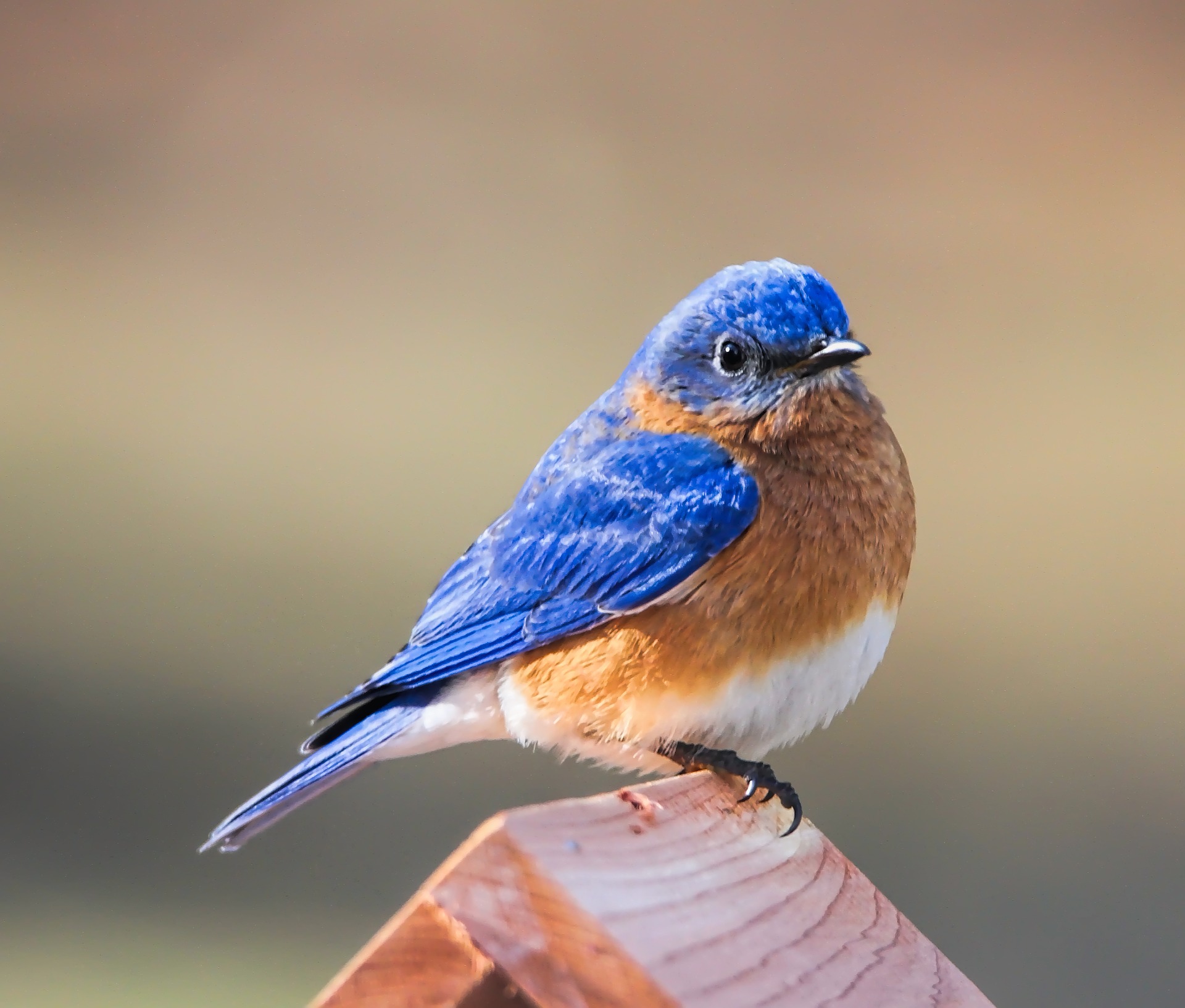
The Eastern Bluebirds are a migratory thrush species that commonly inhabit the orchards, farmlands, and open woodlands throughout North America.
These birds display sexual dimorphism, with the males having a blue head and upperparts coupled with white underparts. On their chest, a bright patch of rufous is visible.
In contrast, their female counterparts have a grey head and upper body, with touches of blue here and there. The rufous patch on their chest is more prominent than the males.
Eared Grebe (Podiceps nigricollis)

Popularly known as the “Black-necked Grebe,” the Eared Grebes are a waterbird species named after the chestnut plumes extending behind their ear coverts.
These birds commonly inhabit the vegetation alongside the freshwater lakes of Europe, Africa, Asia, and the Americas. Within the United States, you can spot them in the western and southern regions.
Eared Grebes are gregarious, often seen in large flocks both in and outside their breeding season.
Eurasian Coot (Fulica atra)
Also referred to as the “Australian Coot,” the Eurasian Coots are ground-dwelling birds of the rail family found in Asia, Australia, Europe, North Africa, and New Zealand.
Both sexes of these birds are sexually monomorphic, having an overall slate-colored body. Their head has iridescent glass, with a white frontal shield extending into a bill.
Eurasian Magpie (Pica pica)
The Eurasian Magpies are the most widespread magpie species found throughout Europe. These birds are well-known for their remarkable intelligence quotient.
They’re sexually monochromatic, with the males being slightly heavier than their female counterparts. The adults have a dark head, breast, back, and tail covered in green or bluish gloss. Their belly is stark white in contrast.
Eurasian Bullfinch (Pyrrhula pyrrhula)
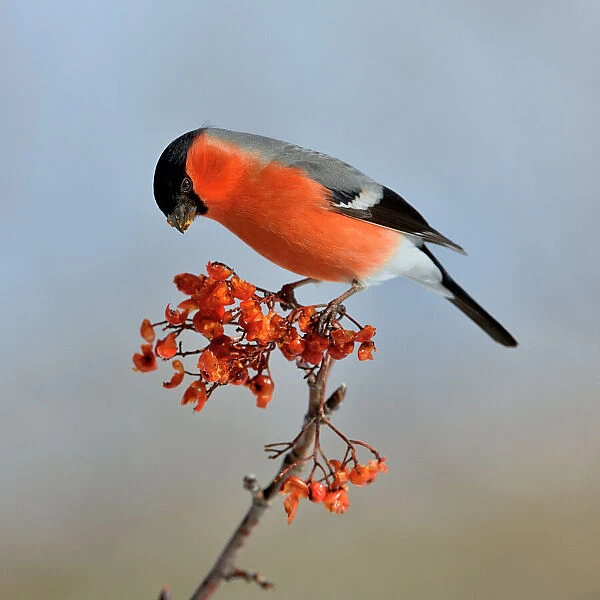
Simply referred to as “Bullfinch” in Europe, the Eurasian Bullfinches are a bull-headed finch species found in temperate Asia and Europe.
These birds have a bulky built, with both sexes having a dark face, wings, and tail. However, the underparts of the males are reddish in color, while the females sport a dull-buff underbody.
Conclusion: Birds That Start With E
That completes our list of birds that begin with the letter E. Thank you for reading.
We truly hope you found the above article on the birds that start with the letter E helpful, and are better equipped to identify them at this point.
If you have any questions whatsoever about anything covered in the above article, feel free to leave your queries by contacting me directly!
Again, don’t forget to share this article using the little buttons below so others can learn about the same things too. Until next time, have a great time exploring more on birds that begin with E!
Birds By Alphabet (A-Z List)
Birds that Start with A
Birds that Start with B
Birds that Start with C
Birds that Start with D
Birds that Start with E
Birds that Start with F
Birds that Start with G
Birds that Start with H
Birds that Start with I
Birds that Start with J
Birds that Start with K
Birds that Start with L
Birds that Start with M
Birds that Start with N
Birds that Start with O
Birds that Start with P
Birds that Start with Q
Birds that Start with R
Birds that Start with S
Birds that Start with T
Birds that Start with U
Birds that Start with V
Birds that Start with W
Birds that Start with X
Birds that Start with Y
Birds that Start with Z





